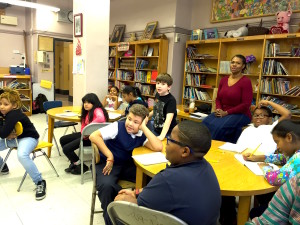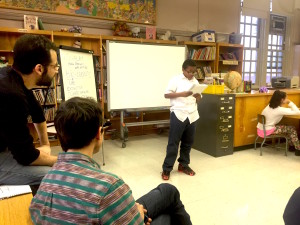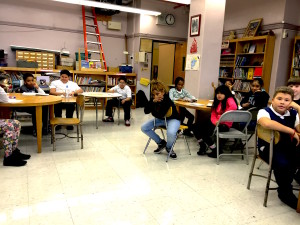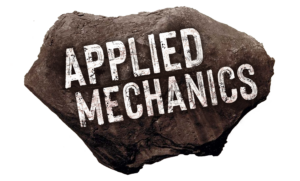By Isabella Sazak
This year is off to a great start. I’m trying new things and accepting new challenges. This is my first blog post ever. And this year I am embarking on a new journey as Lead Teaching artist for Big Green Theater. “Big Green Theater (BGT) is a program developed by The Bushwick Starr and Superhero Clubhouse that combines environmental education with an annual green theater festival. Fifth-grade students from Bushwick schools explore environmental topics with environmental experts, and then are guided in writing original eco-plays. Finished plays are then fully realized at The Bushwick Starr Theater during Earth Week, produced with an ensemble of professional actors, directors, and designers. The plays are created using only green theater methods (recycled materials for sets and costumes, fluorescent and LED lighting, paperless programming, etc.)”
 This year we are focused on the Bio-Diversity Crisis and the 6th Extinction and its relationship with Climate Change. How do you teach fourth and fifth grade students about these huge scary concepts, as well as playwriting in three months without overwhelming them, or lecturing at them for hours? That is the question.
This year we are focused on the Bio-Diversity Crisis and the 6th Extinction and its relationship with Climate Change. How do you teach fourth and fifth grade students about these huge scary concepts, as well as playwriting in three months without overwhelming them, or lecturing at them for hours? That is the question.
BGT is an amazing program, and I have been performing in the festival for the past two years. Last year I also had the chance to work with the students as a volunteer, which was incredibly rewarding and absurdly fun. The plays are nothing short of brilliant; with bright flares of comic genius, and the disarming human insight of innocence. The students are between the ages of 9 and 11. We get them right in that window before the burdens of social expectation, puberty and adolescence turn them into too-cool-for-school Kylo-Ren’s. They are goofy and playful and thirsty for knowledge. As a theater artist struggling with the daily grind it can be easy to forget just how powerful the form is. But watching these students be challenged and nourished by theater, witnessing their voice and confidence in themselves blossom more and more each day is a true salve for any jaded artist’s soul. It only serves to cement my belief that as artists we not only have the responsibility to “hold a mirror up to society” as it were, but to educate our society as well. It is our second greatest responsibility to pass on these tools; generation after generation, not only to survive, but also to thrive peacefully, which is the greater goal in my opinion. And for that to be possible we need more empathetic, creative, critical thinkers being brought up in the world. Unfortunately programs like this are becoming fewer and fewer but we are holding strong. In preparation for this task I have taken to thinking of myself and my assistant teachers as Jedi masters, and my students as young Jedi in training, their tools are art and science. They get that reference, and they enjoy rising to that challenge. I always believe people will rise to the expectations we set them, especially if we also provide them with the support and foundation to get there. I often find myself wishing there had been such a program available for me when I was their age.
 So, to go back to the opening question. How do we teach these young artists about these huge and often very frightening concepts without shutting them down? The answer is lots of games, story-telling and patience. The games are tricky. We have to make them accessible, simple, but clear and true to the information we are trying to communicate. I have learned a lot about creative problem solving, and working with limitations just from trying to construct a simple game to reflect how an ecosystem works, or how biodiversity works in a fun and educational way. That is where teaching becomes an art, and I find that fascinating.
So, to go back to the opening question. How do we teach these young artists about these huge and often very frightening concepts without shutting them down? The answer is lots of games, story-telling and patience. The games are tricky. We have to make them accessible, simple, but clear and true to the information we are trying to communicate. I have learned a lot about creative problem solving, and working with limitations just from trying to construct a simple game to reflect how an ecosystem works, or how biodiversity works in a fun and educational way. That is where teaching becomes an art, and I find that fascinating.
The second half of the program is playwriting, basically learning about story-telling; characters and their wants and conflicts. We learn about tactics and stakes, creating drama, design and song-writing. Part of our philosophy is to always steer the students away from thinking in terms of polarities. i.e. Good vs Evil. There is no such thing in real life, especially when the conversation moves to discussing our role as humans in Climate Change and The Extinction Crisis. It can be easy to demonize a person or group of persons, but we all know it is much more complicated than that. It is very important that our students understand this and embrace this complexity. We never try to give them the answers. We always ask them questions first, encouraging them to figure it out for themselves, mostly because we don’t have all the answers, but more importantly to encourage their independence as critical thinkers. In an educational system that values homogeny over diversity, this is foreign land to some of them, and poetically very related to our subject matter.
There is nothing more universally human than story-telling. It is how we understand our place in the world, and indeed the stories we tell ourselves shape the world we see, and our perception of our place within it so much that it can make or break a person, or a young artist. We are giving these young artists the tools and the space to write their own narratives and that is very empowering. Making Art is how we process, it is the waking dream we engage ourselves in to deepen the lessons learned in life, and it is most important to establish those habits at a young age. Not only that, but by providing them with the tools to do it on their own is truly revolutionary.
 Art can also be incredibly healing. By allowing imaginary circumstances to arise in which we encounter and overcome real past trauma, and current fears we open the soul up further than one could ever expect. There are few events more moving than witnessing a student with serious emotional blocks overcome their fears and find their voice through this program. It makes all the other noise worth it. Art is also the way we connect with the world around us. With technology becoming such a huge part of what it means to be human these days, we are experiencing a strange dichotomy of being so connected online, that we disconnect in real life where it really matters. And these students are deeply engaged in technology already. Sometimes it’s frightening, but it can also be hilariously surprising. There is an act of delicate balance to be made in embracing technology while not allowing it to become a crutch. It is important for us to provide our students with the space to play in the real world, with their bodies and their voices. Serious play is an essential component of learning and artistry; it feeds the imagination and frees up any inhibitions. And we need imaginative, free thinkers to come up with the solutions to our very real and urgent problems. We need brave and kind makers, and hopefully that is what we are helping to cultivate.
Art can also be incredibly healing. By allowing imaginary circumstances to arise in which we encounter and overcome real past trauma, and current fears we open the soul up further than one could ever expect. There are few events more moving than witnessing a student with serious emotional blocks overcome their fears and find their voice through this program. It makes all the other noise worth it. Art is also the way we connect with the world around us. With technology becoming such a huge part of what it means to be human these days, we are experiencing a strange dichotomy of being so connected online, that we disconnect in real life where it really matters. And these students are deeply engaged in technology already. Sometimes it’s frightening, but it can also be hilariously surprising. There is an act of delicate balance to be made in embracing technology while not allowing it to become a crutch. It is important for us to provide our students with the space to play in the real world, with their bodies and their voices. Serious play is an essential component of learning and artistry; it feeds the imagination and frees up any inhibitions. And we need imaginative, free thinkers to come up with the solutions to our very real and urgent problems. We need brave and kind makers, and hopefully that is what we are helping to cultivate.
My students are no less people for being children, they have their wants, and desires, their hopes and dreams. That is a guiding principal for myself, and my colleagues; we never treat our students like children, we never belittle them. We approach them like fellow collaborators and young artists in the making. We have just as much to learn from them as they have to learn from us, and they know it, and that is the absolute truth. Our content heavily informs the way in which we conduct ourselves in this program. It is all about balance, mutual respect and collaboration. There are no winners and no losers, if one loses we all lose. The laws that govern the room when we teach reflect the laws that lead to a balanced environment. Some examples are deep listening, kindness to oneself as well as one’s classmates, taking care of our space, being responsible with love and patience, only taking as much as you need etc. Every group and every system is just a bigger or smaller version of the natural system that governs our planet. We must understand that if we are to grasp the bigger picture of Climate Change, and the Biodiversity Crisis. It is very important for us to keep bringing everything back home, to their reality.
My students are very smart and ahead of the game in so many ways, which is very exciting to us as teachers. They are extremely eager to share their ideas, and desperate to write their plays. This is a very special place to be and we want to encourage them as much as possible, because they will face obstacles, and people who will try to take that away from them. It is truly inspiring to see such open and creative young artists just chomping at the bit to make and write. It gives me more tangible hope than anything else in the world that our future can still be bright. But we have to keep up programs like this. We have to keep nourishing our creativity and our desire for community. We have to empower ourselves and our youth to speak out, and stand up for what they believe in. That is why I take my job so very seriously. Yes it is also a great deal of fun, and we play games and tell funny stories and make up funny characters but at the end of the day it’s all for the greater health of our species and our planet. I am incredibly honored to be a part of this program, and I have already learned so much. I look forward to teaching, and sharing the power of art and theater with many more young artists to come, and learning from them in return. I encourage all grown-up artists to find a way to do the same in their own way.
For more info about Superhero Clubhouse http://www.superheroclubhouse.org/
About BGT http://www.superheroclubhouse.org/big-green-theater
About the Bushwick Starr http://www.thebushwickstarr.org/
